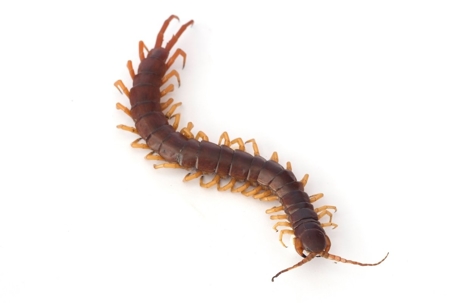Centipedes In Virginia
In Northern Virginia, several species of centipedes are found both outdoors and inside homes. The most common centipedes in Northern Virginia include the following:
House Centipedes (Scutigera coleoptrata)
House centipedes (Scutigera coleoptrata) are moderately common in Northern Virginia, particularly in homes with basements, crawl spaces, or damp areas. Here’s a detailed breakdown:
Geographic suitability: Northern Virginia’s climate—humid summers and mild to cold winters—creates favorable conditions for house centipedes. They thrive in areas with moisture and can survive indoors year-round.
Habitat preferences: These centipedes prefer damp, dark environments such as basements, bathrooms, laundry rooms, and under sinks. They are more likely to appear in older homes with leaks, poor ventilation, or high humidity.
Seasonal trends: While they can be found year-round indoors, they are most noticeable in the spring and fall, when they may migrate indoors from outdoor hiding spots seeking food or moisture.
Population levels: They are not as common as ants or cockroaches but are frequent enough that our pest control professionals in Northern Virginia encounter them regularly, especially in areas near wooded lots or poorly maintained foundations.
Behavior: House centipedes are predators, feeding on other household pests like spiders, silverfish, and cockroaches, which sometimes leads to their presence being a natural form of pest control rather than an infestation problem.
Homes with low humidity, well-sealed foundations, and reduced clutter tend to see fewer house centipedes. Moisture control and sealing cracks around doors and windows significantly reduce their indoor presence.
Eastern Red Centipede (Lithobius forficatus)
Eastern red centipedes (Scolopocryptops sexspinosus and similar species) are much less common indoors than house centipedes in Northern Virginia, and their presence is mostly outdoors:
Geographic and habitat distribution: Eastern red centipedes are native to the eastern United States, including Virginia. They prefer moist, shaded environments such as leaf litter, under logs, mulch, and soil. Northern Virginia’s forests, gardens, and yards with heavy mulch or compost are ideal habitats.
Indoor occurrence: Unlike house centipedes, eastern red centipedes rarely enter homes. When they are found indoors, it is usually accidental—through cracks in foundations, doors, or windows, often near basements or crawl spaces.
Seasonal trends: They are most active in spring and fall when temperatures are moderate and moisture is high. Winter typically drives them deeper into soil or under debris.
Behavior: They are solitary predators, feeding on insects, spiders, and other small invertebrates. They do not infest homes or reproduce indoors like house centipedes.
Population levels: Outdoors, they can be locally abundant in heavily mulched gardens or wooded yards. However, compared to house centipedes, their encounters with homeowners are relatively rare unless your property has extensive damp, covered areas.
To reduce accidental indoor sightings, keep mulch and leaf litter away from the foundation, seal cracks, and maintain good drainage around the home.
Soil Centipedes (Geophilomorpha species)
Soil centipedes (typically members of the order Geophilomorpha, also called “earth centipedes”) are relatively common outdoors in Northern Virginia, but like eastern red centipedes, they are rarely seen inside homes:
Geographic distribution: Soil centipedes are widespread across the eastern United States, including Northern Virginia. The region’s moderate climate and seasonal rainfall support moist soils, leaf litter, and decaying organic matter where these centipedes thrive.
Preferred habitats: They inhabit soil, leaf litter, mulch, under logs, and garden beds, often in shaded, damp areas. They are burrowers, moving vertically through soil to avoid drying out.
Indoor presence: Soil centipedes almost never establish indoors because they require soil contact and high humidity. Occasional sightings in basements or crawl spaces are usually accidental, such as when soil is tracked in or through foundation cracks.
Seasonal activity: They are most active in spring and fall, when the soil is moist and temperatures are moderate. During hot, dry summers or frozen winters, they burrow deeper into soil to survive.
Population levels: Outdoors, soil centipedes are locally abundant wherever organic matter and moisture accumulate. They are predators, feeding on small invertebrates like insects, larvae, and worms. Their presence in gardens is generally harmless and beneficial.
Since they rarely enter homes, control is usually unnecessary. Reducing excessive mulch and keeping the soil around foundations dry can minimize rare indoor appearances.
Bark Centipede (Hemiscolopendra marginata)
Bark centipedes (typically species in the family Lithobiidae, sometimes called “stone centipedes”) are relatively uncommon in Northern Virginia, and their presence is mostly outdoors rather than in homes:
Geographic distribution: Bark centipedes are native to temperate regions of North America, including Northern Virginia. They are primarily found in forests, wooded lots, and areas with abundant leaf litter or decaying wood.
Preferred habitats: These centipedes favor under bark, stones, logs, and in soil crevices. They need moisture and shelter, so they are typically found in shaded, damp environments outdoors rather than in dry, open areas.
Indoor occurrence: Bark centipedes rarely enter homes. When they are seen indoors, it is usually accidental, for example, carried in on firewood, mulch, or plants. They do not establish populations inside structures.
Behavior and diet: They are small, fast-moving predators feeding on insects, spiders, and other small arthropods. They play an important ecological role in controlling insect populations outdoors.
Seasonal activity: Most active in spring and fall, when humidity is high and temperatures are moderate. During winter, they retreat under bark or stones to avoid freezing, and in summer they burrow deeper or hide under debris to avoid desiccation.
Population levels: Locally, bark centipedes can be found wherever suitable habitats exist, but they are less frequently encountered than house centipedes or eastern red centipedes. Their presence is mostly noticed by naturalists or gardeners, rather than homeowners.
Keeping firewood, mulch, and leaf litter away from the foundation, sealing cracks, and controlling moisture near the home are sufficient to prevent occasional indoor sightings.
In and around Northern Virginia homes, house centipedes are by far the most common indoor species, while red centipedes and soil centipedes dominate outdoor environments. Their presence indoors is often linked to excess moisture, insect prey, and entry points around foundations or plumbing.

